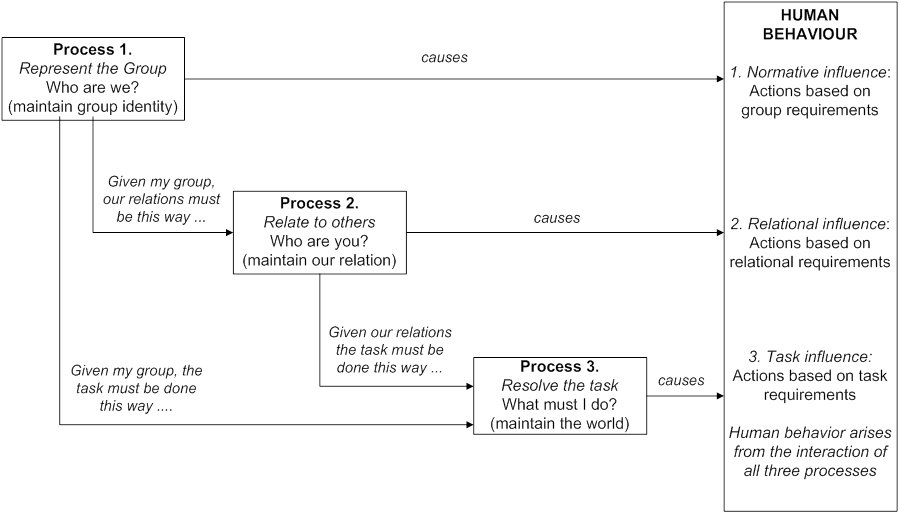Communication goals can be classified by level as follows:
1) Informational. The goal is to analyze information about the world and decide a best choice, but this rational analysis process is surprisingly fragile (Whitworth et al., 2000).
2) Personal. The goal is to form reliable interpersonal relationships. Relating involves a turn-taking, mutual-approach process, to manage the emotional arousal evoked by the presence of others (Short et al., 1976). Friends are better than information.
3) Community. The goal is to stay part of the group. Belonging to a community means being part of it, and so protected by it. Communities outlast friends.
The Maori Haka illustrates communication used when two warbands meet that both binds the group and sends a message to the other group that they are not to be trifled with.
|
Goal |
Influence |
Linkage |
Questions |
|
Analyze task information |
Informational influence |
Broadcast |
What is right?What is best? |
|
Relate to other people |
Personal influence |
Interpersonal |
Who do I like?Who do I trust? |
|
Belong to a community |
Normative influence |
Matrix |
What are the others doing? Am I “in” the group? |
Table 3.2: Communication goals and influence by preferred linkage
Table 3.2 shows how the level goals map to influence and linkage types. People online or off analyze information, relate to others and belong to communities, so are subject to informational, personal and normative influences. Normative influences are based on neither logic nor friendship; an example is patriotism, loyalty to your country whether its actions are right or wrong. Even brothers may kill each other on a civil war battlefield.
People are influenced by community norms, friend views and task information, in that order, via different semantic streams. Semantic streams arise as people process a physical signal in different ways to generate different meanings. So one physical message can at the same time convey:
1) Message content. Symbolic statements about the world, e.g. a factual sentence, give informational influence.
2) Sender state. Sender psychological state, e.g. an agitated tone of voice, gives relational influence.
3) Group position. Sender intent merged over many senders to get group intent, e.g. a vote, gives normative influence.
Human communication is subtle because one message can have many meanings and people respond to them all at once. So when leaving a party I may say: “I had a good time” but by tone imply the opposite. I can say “I AM NOT ANGRY!” in an angry voice. Note that some people do not process the sender state semantic stream, e.g. those with autism.What is less obvious is that a message can also indicate a position, or intent to act, e.g. to say “Thanks, I had a good time” in a certain tone or with certain body language can indicate an intention to leave a party.
What makes human communication complex is that a single physical signal can have as many semantic streams as the medium allows. Face-to-face talk allows three streams, but computer communication is usually more restricted, e.g. email text mainly just gives content information.
Community level systems using matrix communication include:
1) The reputation ratings of Amazon or E-Bay give community-based product quality control. Slashdot does the same for content, letting readers rate comments to filter out poor ones.
2) Social bookmarks, like Digg and Stumbleupon, let users share links, to see what the community is looking at.
3) Tag technologies increase the font size of links according to frequency of use. As people walk in a forest walk on tracks trod by others, so we can now follow web-tracks on browser screens.
4) Twitter’s follow function lets leaders broadcast ideas to followers and people choose the leaders they like.
The power of the computer can allow very fast matrix communication by millions or billions. What might a global referendum on current issues reveal? The Internet could tell us.
How these three basic cognitive processes, of belonging, relating and fact analysis, work together in the same person is shown in Figure 3.7.

The details are given elsewhere (Whitworth et al., 2000), but note that the rational resolution of task information is the third priority cognitive process, not the first. Only if all else fails do we stop to think things out or read instructions. Figure 3.8 shows how the three cognitive processes of belonging, relating and analyzing task information take priority in that order for most people. The Three Process Model predicts that people mostly make decisions based on relating to others as Facebook offer and following the majority as Google and Twitter enable.

In conclusion:
The first level of the World Wide Web, an information library accessed by search tools, is well in place.
The second level of the World Wide Web, a medium for personal relations, is also well under way.
The third level of the World Wide Web however, a civilized social environment, is the current and future challenge, as even a cursory study of Robert’s Rules of Order will dispel any illusion that social dealings are simple (Robert, 1993).
Socio-technology lets hundreds of millions of people act together, but we still do not know what Here Comes Everybody means (Shirky, 2008). The issue of the power of communities is illustrated as follows:
Question: Where does an 800lb Gorilla sit when it comes to dinner?
Answer: Anywhere it wants to. Communities are like this but first they must agree to act as one, which can take years. How exactly many people decide to act as one has always been a bit of a mystery, yet this is what we must learn to bring group applications to an Internet full of personal applications. Group writing and publishing, group browsing, group singing and music (online choirs and bands), group programming and group research illustrate the many areas of current and future potential in online group activity. The future of the Internet is in more private online communities that are hard to get into.